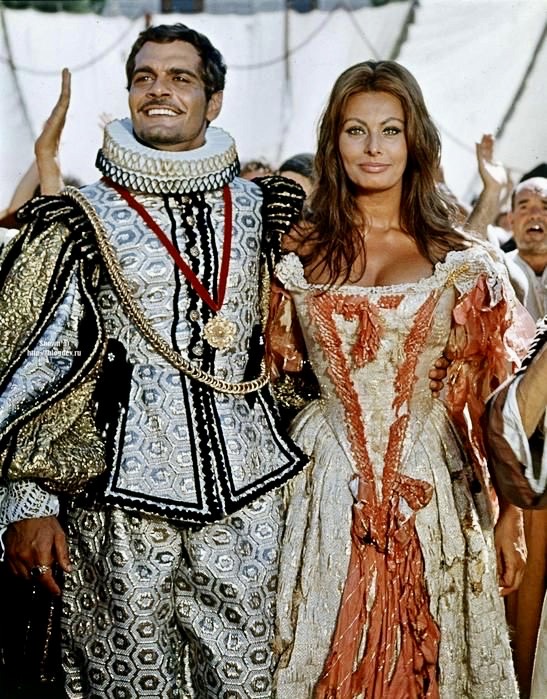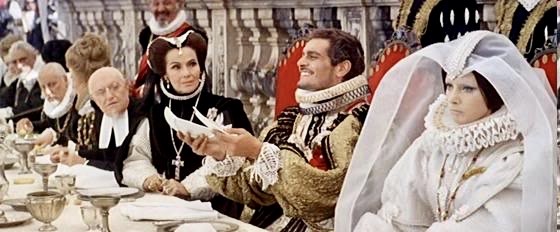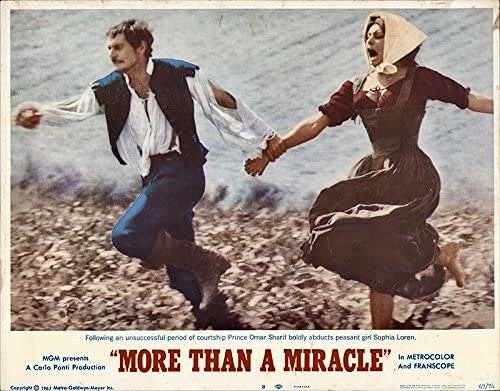
Will there be a happy ending for Prince Rodrigo (Omar Sharif) and Isabella Candeloro (Sophia Loren) in More Than a Miracle (1967), directed by Francesco Rosi.
Imagine, if you can, a rustic Neapolitan fairy tale directed by Francesco Rosi in the docudrama style of his post-neorealism films of the early sixties like The Moment of Truth (1965), shoot it in Technicolor and Techniscope, add a lush musical score by Piero Piccioni and you get More Than a Miracle (1967), a zesty Southern Italian fantasy-romance that was more appropriately titled Cinderella, Italian Style in Europe.
 Sophia Loren, who has rarely looked more beautiful, plays Isabella, a poor peasant girl who falls in love with the handsome but arrogant Prince Rodrigo. Knowing she can’t compete with the seven aristocratic princesses vying to become Rodrigo’s bride, Isabella resorts to witchcraft with the help of a mischievous crone. But the love spell they cast on Rodrigo doesn’t quite work (he is temporarily frozen in mid-meal, unable to lower his hand from his mouth) and Isabella eventually realizes she must win him without the aid of magic.
Sophia Loren, who has rarely looked more beautiful, plays Isabella, a poor peasant girl who falls in love with the handsome but arrogant Prince Rodrigo. Knowing she can’t compete with the seven aristocratic princesses vying to become Rodrigo’s bride, Isabella resorts to witchcraft with the help of a mischievous crone. But the love spell they cast on Rodrigo doesn’t quite work (he is temporarily frozen in mid-meal, unable to lower his hand from his mouth) and Isabella eventually realizes she must win him without the aid of magic.

Prince Rodrigo (Omar Sharif) is the victim of a witch’s love spell in More Than a Miracle (1967), an Italian fairy tale.
Loren’s husband, producer Carlo Ponti, wanted to make sure that More Than a Miracle would have a broad international appeal and cast the film accordingly. Dolores del Rio, the exotic Mexican beauty who enjoyed Hollywood stardom during the thirties, was selected for her marquee value and glamorous appearance (she plays the prince’s marriage-minded mother).

Hollywood legend Dolores del Rio plays the Queen Mother in Francesco Rosi’s fairy tale, More Than a Miracle (1967).
It also features Georges Wilson, a French character actor who often appeared as judges, priests, inspectors and autocrats in numerous European films like Luchino Visconti’s The Stranger (1967) and Lucio Fulci’s The Conspiracy of Torture (1969). The rest of the cast were relatively unknown Italian actors except for Omar Sharif, who was chosen to play the prince.

Flying monks, witches, love spells and dishwashing contests make More Than a Miracle (1967) an eccentric fairy tale for Italian film lovers.
At the time, Sharif was at the height of his popularity thanks to his performance in Doctor Zhivago (1965) plus Sharif and Loren had previously worked well together in The Fall of the Roman Empire (1964). For a brief time, Loren was even considered as Sharif’s love interest in Doctor Zhivago before Julie Christie won the role. Yet even though Loren was happily married to Ponti, the tabloids were still full of speculations about a possible off-screen romance between the two stars during filming.

Francesco Rosi (left) directs Omar Sharif and Sophia Loren in a scene from More Than a Miracle (1967).
Although More Than a Miracle is set in 17th century Italy, the movie was actually shot in the countryside surrounding Naples, the city where Loren spent her childhood. The choice of Francesco Rosi for director was an unusual one since his previous features were serious docudramas with social and political themes (Salvatore Giuliano (1961), Hands Over the City, 1963) and were obviously influenced by such neorealism classics as The Bicycle Thief (1948) and Umberto D. (1952).  Nevertheless, Rosi clearly demonstrates a flair for the fantastic in More Than a Miracle and even manages to smuggle in some of his previous thematic concerns in his depiction of the huge gulf between the aristocratic and peasant classes. In the biography Sophia by Stefanio Masi and Enrico Lancia, Rosi envisioned Isabella as “a farm girl with all of the naivete and cunning of a woman of the people. Sophia gave a distinguished portrayal of her. She’s a great worker….You can ask any sacrifice of her. I remember that I asked her to always perform barefoot. Keep in mind that the ground she had to walk on with her bare feet was rough and rugged. Sophia has very beautiful feet. She was very patient: she moved forward fearlessly, as if she had walked barefoot all her life. Sometimes her feet would bleed, but she didn’t complain. Unlike many Neapolitans, Sophia never complains.”
Nevertheless, Rosi clearly demonstrates a flair for the fantastic in More Than a Miracle and even manages to smuggle in some of his previous thematic concerns in his depiction of the huge gulf between the aristocratic and peasant classes. In the biography Sophia by Stefanio Masi and Enrico Lancia, Rosi envisioned Isabella as “a farm girl with all of the naivete and cunning of a woman of the people. Sophia gave a distinguished portrayal of her. She’s a great worker….You can ask any sacrifice of her. I remember that I asked her to always perform barefoot. Keep in mind that the ground she had to walk on with her bare feet was rough and rugged. Sophia has very beautiful feet. She was very patient: she moved forward fearlessly, as if she had walked barefoot all her life. Sometimes her feet would bleed, but she didn’t complain. Unlike many Neapolitans, Sophia never complains.”  One of the chief virtues of More Than a Miracle is the evocative cinematography by Pasqualino De Santis which accents the 17th century period detail and the sunbaked landscapes of Basilicata, Campania and other Southern Italian locations. De Santis would go on to win the Oscar for Best Cinematography for Franco Zeffirelli’s Romeo and Juliet (1968) and his other career highlights include The Damned (1969), Death in Venice (1971) and Robert Bresson’s Lancelot de Lac (1974).
One of the chief virtues of More Than a Miracle is the evocative cinematography by Pasqualino De Santis which accents the 17th century period detail and the sunbaked landscapes of Basilicata, Campania and other Southern Italian locations. De Santis would go on to win the Oscar for Best Cinematography for Franco Zeffirelli’s Romeo and Juliet (1968) and his other career highlights include The Damned (1969), Death in Venice (1971) and Robert Bresson’s Lancelot de Lac (1974).

The Queen Mother (Dolores del Rio) and Prince Rodrigo (Omar Sharif) preside over a royal banquet in the Italian fairy tale, More Than a Miracle (1967).
When More Than a Miracle opened theatrically, it was well received by most Italian film critics but failed to find an audience outside its own country. Maybe the mixture of flying monks, jousting tournaments, cackling witches and dishwashing contests (a major set piece near the end of the film) was just too eclectic for American moviegoers. Either that or sixties audiences felt they were too hip for an old-fashioned fairy tale.  Pauline Kael, critic for The New Yorker, commented on the film’s visual beauty and oddball charm that “has some of the magical silliness and sweetness of De Sica’s Miracle in Milan and the Alexander Korda production of The Thief of Bagdad…the dubbing is both funny and charming, especially when the warty old witches speak in voices that seem to come from another planet. (Some of them were actually Italian peasant men dressed as women, and some were elderly English actresses).” The reviewer for Time magazine was also captivated by it: “That anybody would bother these days to make so slender and fanciful a film is a miracle in itself; to do it with such a profusion of visual beauty is More Than a Miracle.”
Pauline Kael, critic for The New Yorker, commented on the film’s visual beauty and oddball charm that “has some of the magical silliness and sweetness of De Sica’s Miracle in Milan and the Alexander Korda production of The Thief of Bagdad…the dubbing is both funny and charming, especially when the warty old witches speak in voices that seem to come from another planet. (Some of them were actually Italian peasant men dressed as women, and some were elderly English actresses).” The reviewer for Time magazine was also captivated by it: “That anybody would bother these days to make so slender and fanciful a film is a miracle in itself; to do it with such a profusion of visual beauty is More Than a Miracle.”

Sophia Loren plays a peasant girl who uses witchcraft to win a prince in More Than a Miracle (1967).
One of the few negative reviews came from Bosley Crowther of The New York Times who called it “no less than a mess, a pointless comedy” but also added, “it has been extraordinarily well-photographed in color. However, grand vistas of tawny-colored wheat fields and beautifully framed shots of medieval castles and tournaments cannot hide the essential humorlessness and confusion of a story that is part spectacle, part love story, part fantasy and part farce.”

Omar Sharif plays a dashing prince in Francesco Rosi’s romantic fantasy, More Than a Miracle (1967), co-starring Sophia Loren.
Still, More Than a Miracle is not a typical fairy tale at all and it’s a little too bawdy for children what with Sophia’s tight peasant blouses on the verge of popping open or odd scatological humor like the famous urine cure scene at the nunnery. The only aspect of the film that generated any major buzz at all were the peasant outfits worn by Sophia in the film (they were designed by Giulio Coltellacci); their natural, free-flowing quality actually influenced mainstream fashion at the time which quickly glamorized the rustic rag-tag look.  For many years More Than a Miracle was only available on VHS but in June 2014 it was released on DVD in the English language version by the Warner Archive Collection. The disc sports an attractive if unexceptional widescreen presentation and has no extra features other than a theatrical trailer. A major upgrade to Blu-ray would be most welcome along with the Italian language version with English subtitles.
For many years More Than a Miracle was only available on VHS but in June 2014 it was released on DVD in the English language version by the Warner Archive Collection. The disc sports an attractive if unexceptional widescreen presentation and has no extra features other than a theatrical trailer. A major upgrade to Blu-ray would be most welcome along with the Italian language version with English subtitles.  *This is a revised and expanded version of an article that originally appeared on the Turner Classic Movies website.
*This is a revised and expanded version of an article that originally appeared on the Turner Classic Movies website.
Other websites of interest:
http://sensesofcinema.com/2003/great-directors/rosi/
https://www.theguardian.com/film/2015/jan/11/francesco-rosi
https://www.thedailybeast.com/from-desert-bandit-to-bridge-player-omar-sharif
https://www.youtube.com/watch?v=LKwMqi9on5g
